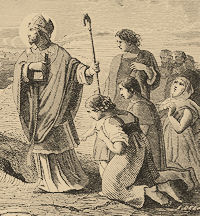
Daily Readings for: September 25, 2012
(Readings on USCCB website)
Collect: O God, who founded all the commands of your sacred Law upon love of you and of our neighbor, grant that, by keeping your precepts, we may merit to attain eternal life. Through our Lord Jesus Christ, your Son, who lives and reigns with you in the unity of the Holy Spirit, one God, for ever and ever.
Ordinary Time: September 25th
Tuesday of the Twenty-Fifth Week in Ordinary Time
Old Calendar: St. Finbar, bishop (Hist)
Historically today is the Feast of St. Finbar who lived in the sixth century in Ireland. He was a native of Connaught, and instituted a monastery or school at Lough Eirc, to which such numbers of disciples flocked, that it changed a desert into a large city. This was the origin of the city of Cork, which was built chiefly upon stakes, in marshy little islands formed by the river Lea. His baptismal name was Lochan; the surname Finbarr, or Barr the White, was given to him after. He was Bishop of Cork seventeen years, and died in the midst of his friends at Cloyne, fifteen miles from Cork. His body was buried in his own cathedral at Cork, and his relics, some years after, were put in a silver shrine, and kept there, this great church bearing his name to this day. St. Finbarr's cave or hermitage was shown in a monastery which seems to have been begun by our Saint, and stood to the west of Cork.
St. Finbarr
The patron saint of Cork, was born in Achaid Duborcon near Crookstown, Co. Cork, the son of a Connacht father, a metalworker, who moved to Munster to find work and married a slave girl.
Finbarr left home with three unidentified ascetics and spent much time in Scotland before establishing various hermitages in his native area, notably at Kilclooney and on an island in Gougane Barra, which bears his name.
Among many wondrous tales associated with him is, one in which he is led by an angel from the source of the river Lee at Gougane Barra to its marshy mouth, where he founded his most important monastery, out of which grew the see and the city of Cork. Another of Finbarr's great legends was the chase and expulsion of the great lake serpent from the lake in Gougane, which created the channel that is now the river Lee.
Finbarr died at Cloyne in 633 ad and his remains were taken to Cork to be enclosed in a silver shrine. A pattern is made to Gougane Barra on the Sunday nearest to the feast of St Finbarr which falls on the 25th of September.